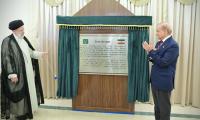KARACHI: The rupee sharply fell 5.3 percent against the dollar to an all-time low of 128 on Monday in an apparent devaluation by the central bank as shrinking forex reserves are exerting pressure on the country’s external account.
The central bank said the rupee closed at 128 per dollar in the interbank market against the closing level of Rs121.55 the previous day. The stocks exchange slid by 600 basis points, while the country debt increased by Rs800 billion.
“… this adjustment in the exchange rate along with the increased policy rate and other administrative measures would help contain domestic demand in general, and reduce imbalances in the country’s external accounts in particular,” the State Bank of Pakistan (SBP) said in a statement.
Rupee has lost approximately 20 percent against the dollar since December last. It lost about four percent in June, after weakening 10 percent in March this year and December last.
The SBP said strong demand for imports had pushed the country’s current account deficit to the levels not sustainable beyond the short run despite a double-digit growth in exports.
“This movement in the exchange rates reflects the demand-supply gap of the foreign exchange in the interbank market." Rupee traded as high as 129.4 against the dollar in the early hours of the market. The local currency, however, closed at 128.75/dollar in the kerb market, compared to the previous level of 124.10.
Analysts see rupee devaluation as the spadework for a possible IMF bailout to reinvigorate the country’s fragile external account. Zafar Paracha, General Secretary at Exchange Companies Association of Pakistan, said the fresh round of currency devaluation should be seen in the context of a new bailout from the IMF. The country concluded a three-year IMF loan program of $6.7 billion in September 2016.
“There is no major foreign currency demand. However, an increase in dollar rates in the open market is reflective of steep rupee depreciation in the interbank trade,” Paracha said.
A trader, however, said there was shortage of dollars due to higher demand caused by foreign debt repayments. “The SBP increased one percent interest rates that indicate higher inflation and tumbling balance of payments,” the trader said, requesting anonymity. “Along with this, the IMF has also suggested devaluation in the PKR.”
Paracha said a high level of volatility in the interbank market pushed people to buy more dollars to meet their requirements. “Exporters are reluctant to sell the greenback in order to maximise their profits.”
Markets and investors were expecting further five to seven percent exchange rate adjustment till the end of the current fiscal year as a result of depletion of foreign reserves. Yet, they were not prepared for such an abrupt currency fall just after a month.
Bilal Khan, senior economist at Standard Chartered Bank, said the action under the interim government shows that Pakistan is likely to seek an IMF program as a matter of urgency after a new government is formed after elections scheduled on July 25.
“We maintain our view that regardless of who wins Pakistan will find it difficult to manage its precarious external position without the IMF assistance,” Khan said. “As such, we think the recent tightening lays the groundwork for an IMF deal.”
The economist said policy insiders see further rupee depreciation to more than 130 in the coming months, warranting monetary tightening. “We think the SBP will go further… our base case is for another 100bps (basis points) hike, taking the policy rate to 8.5 percent by end-2018,” Khan said.
Sakib Sherani, Chief Executive Officer at Macroeconomic Insight, said the magnitude and duration of rupee weakness depended on when Pakistan signed up to a fund program – or managed to arrange forex reserves-bolstering hard currency from alternative sources.
“Moving to a free-float of the exchange rate is very likely to be a prior action for the next IMF program, should the new government decide to make an approach to the Fund,” Sherani said in a report of Alfalah Securities.
Analysts said the weak rupee is needed to support deteriorating external account position. “We believe this is much needed as external account continues to deteriorate,” Topline Research said in a flash note.
Current account deficit is expected to increase to a whopping $18 billion, 5.8 percent of GDP in FY2018, compared to $12.6 billion or 4.1 percent of GDP in the previous fiscal year.
“This is not sustainable given current low level of reserves of $9.5 billion – less than two months imports – as of July 6,” the brokerage said.
Analysts said rupee depreciation would fan inflationary pressures. Paracha demanded the Chief Justice of Pakistan Mian Saqib Nisar to take suo motu action against the sudden currency depreciation by the central bank. “The chief justice should ask the exchange rate management authorities about the mechanism of the currency devaluation.”
Awami Muslim League chief appeared in the court with his lawyers Sardar Raziq and Sardar Shehbaz
Board meeting also allowed increase in business center and commercial area of hotel plots from 5 to 10 percent along...
Foreign exchange reserves currently stand at $8 billion, while Pakistan would also receive $1.1 billion IMF tranche:...
CM directed that the enforcement authorities be made functional in six months, and legislation in this regard be...
Pakistani soldiers and policemen stand guard outside the Haripur central jail. — AFP/FileWASHINGTON: The Pakistani...
Establishment Division has also issued an NoC to fill 465 civilian posts in the Ministry of Defence and 11 posts in...







